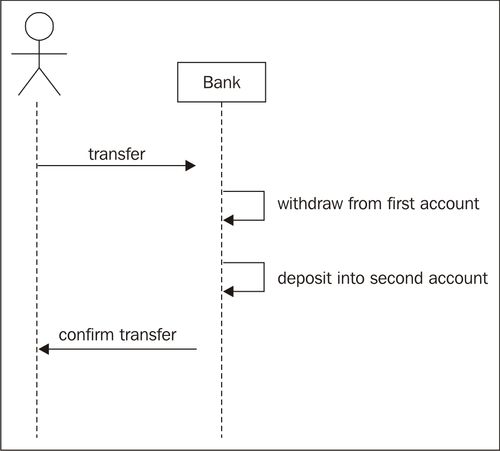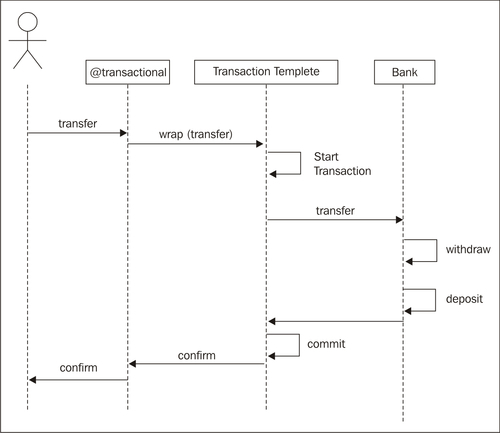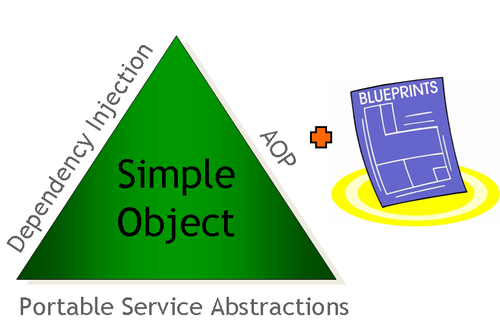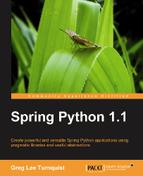Spring Python solves these problems with its TransactionTemplate. This utility class makes it easy to wrap business methods with transactional functionality that solves all of the problems listed earlier. Spring Python makes it easy to wrap our existing business functions with the TransactionTemplate using its @transactional decorator.
- First, let's take our simple
transferfunction, and put into aBankclass.from springpython.database.core import * from springpython.database.factory import * class Bank(object): def __init__(self, connectionFactory): self.factory = connectionFactory self.dt = DatabaseTemplate(self.factory) def transfer(self, transfer_amt, source_act, target_act): self.dt.execute(""" update ACCOUNT set BALANCE = BALANCE - %s where ACCOUNT_NUM = %s""", (transfer_amt, source_act)) self.dt.execute(""" update ACCOUNT set BALANCE = BALANCE + %s where ACCOUNT_NUM = %s""", (transfer_amt, target_act))In this situation, we have stripped out all the hand-coded transaction code. Instead, we have the simple, concise business logic that defines a
transferoperation.Note
Please note, this version of the Bank application is NOT yet safe.
The steps are easily shown with the following sequence diagram:

- Now let's wrap our
transfermethod with transaction protection by using Spring Python's@transactionaldecorator.from springpython.database.core import * from springpython.database.factory import * from springpython.database.transaction import * class Bank(object): def __init__(self, connectionFactory): self.factory = connectionFactory self.dt = DatabaseTemplate(self.factory) @transactional def transfer(self, transfer_amt, source_act, target_act): self.dt.execute(""" update ACCOUNT set BALANCE = BALANCE - %s where ACCOUNT_NUM = %s""", (transfer_amt, source_act)) self.dt.execute(""" update ACCOUNT set BALANCE = BALANCE + %s where ACCOUNT_NUM = %s""", (transfer_amt, target_act))
@transactional is a decorator that uses a hidden instance of TransactionTemplate to execute our transfer function inside a very robust version of the transaction pattern. Our interactions are better shown in the following diagram.

- Because
@transactionalwraps ourtransferfunction, when the user invokestransfer, they are hitting the decorator first @transactionalpasses all the context of the requested method call to its private instance ofTransactionTemplateTransactionTemplatestarts a transactionTransactionTemplatethen calls the originalBank transferfunctionBankcarries out its business, totally unaware it is inside a transaction- When complete,
Bankhands control back to theTransactionTemplate, which issues acommit TransactionTemplatehands control back to@transactional, and finally back to the caller
- Since
TransactionTemplateis the caller oftransfer, it can easily handle any number of return statements. If an exception is raised anywhere insidetransfer, TransactionTemplatewillrollbackinstead ofcommit.
With this clean separation of concerns, we can work on the business code without having to worry about getting transactions right.
Our first version of the transaction pattern was simple and naïve. We then examined the list of issues with that pattern. TransactionTemplate has a much more sophisticated pattern that handles these extra situations:
- It handles the simple case of catching any exception thrown by catching it, issuing a rollback, and then re-throwing the exception
- It handles all return statements by catching the return value of the method, issuing the necessary commit, and then finally returning the results
@transactionalis coded by default to start new transactions if one isn't currently in progress, and to join a transaction if one already exists. We will look at the other transactional options later in this chapter
Another integrity gap exists in our transfer code. It lies somewhere between the transaction pattern and our business logic. Can you spot it?
There are no checks to make sure that we even have $10,000 to transfer! Also, there is no type of security check ensuring that we own either of these two accounts. We will address this deficiency later on, when filling in the transactional details.
We're not done yet. In order to have @transactional do its job, we need to link it with a Transaction Manager through an AutoTransactionalObject. The Transaction Manager provides @transactional with a handle into the database to issue necessary commits and rollbacks. It also tracks the context of existing transactions and make appropriate decisions about when to start new transactions.
- To inject everything, let's define a pure Python IoC container that links
ConnectionFactoryTransactionManagerto@transactionthrough anAutoTransactionalObject.from springpython.database.transaction import * TransactionTemplateaboutclass BankAppConfig(PythonConfig): def __init__(self, factory): PythonConfig.__init__(self) self.factory = factory @Object def transactionalObject(self): return AutoTransactionalObject(self.tx_mgr()) @Object def tx_mgr(self): return ConnectionFactoryTransactionManager(self.factory) @Object def bank(self): return Bank(self.factory)
tx_mgrdefines our Transaction Manager, which uses an injected factory in order to perform the SQL transaction APIs. This is the same type of factory used byDatabaseTemplate. tx_mgrtracks when transactions begin and end, providing the necessary services forTransactionTemplateand@transactional.transactionalObjectdefines an instance ofAutoTransactionalObject, an IoC post processor. Its job is to find all instances of@transactionaland link them with thetx_mgr. This is what empowers@transactionalto do its job of ensuring data integrity through SQL transactions.- The
bankclass is our business class.
- Now, let's write some startup code to perform the
transfer.if __name__ == "__main__": from springpython.context import ApplicationContext ctx = ApplicationContext(BankAppConfig( Sqlite3ConnectionFactory("/path/to/sqlite3db"))) service = ctx.get_object("bank") bank.transfer(10000.0, "SAVINGS", "CHECKING")
We saw this diagram earlier in the book, as an illustration of the key principles behind Spring Python.

TransactionTemplate represents a Portable Service Abstraction.
- It is portable because it uses Python's standardized API for SQL transactions, not tying us to any database vendor or custom database connection library
- It provides the useful service of letting us easily wrap methods with a sophisticated and powerful transaction pattern
- It offers a nice abstraction to writing transactional code, without requiring us to handle the SQL transaction APIs directly
Our banking example has shown how to decorate some business logic with Spring Python's @transactional in order to make the operation transactional. Throughout the example, we have repeatedly mentioned TransactionTemplate.
In this section, we will use TransactionTemplate directly instead of @transactional. We will also explore how to do this with and without IoC configuration.
- First, let's rewrite
Bank, replacing@transactionalwithTransactionTemplate.class Bank(object): def __init__(self, connectionFactory): self.factory = connectionFactory: self.dt = DatabaseTemplate(self.factory) self.tx_mgr = ConnectionFactoryTransactionManager(self.factory) self.tx_template = TransactionTemplate(self.tx_mgr) def transfer(self, transfer_amt, source_act, target_act): class TxDefinition(TransactionCallbackWithoutResult): def doInTransactionWithoutResult(s, status): self.dt.execute(""" update ACCOUNT set BALANCE = BALANCE - %s where ACCOUNT_NUM = %s""", (transfer_amt, source_act)) self.dt.execute(""" update ACCOUNT set BALANCE = BALANCE + %s where ACCOUNT_NUM = %s""", (transfer_amt, target_act)) self.tx_template.execute(TxDefinition())This version of our
Bankshows two more attributes:tx_mgrandtx_template. These could be injected into our class, but we chose to inject the connection factory only.- This inner class defines one method:
doInTransactionWithoutResult, which contains our business logic. - To avoid confusion between
selfpassed intotransferandselfpassed intoTxDefinition, doInTransactionWithoutResultnames its first arguments. - Because transfer is not expected to return anything, it uses
TransactionCallbackWithoutResultas a base class. For return values, useTransactionCallback/doInTransactioninstead.
- This inner class defines one method:
- Next, let's adjust the IoC configuration to handle these changes.
from springpython.database.transaction import * class BankAppConfig(PythonConfig): def __init__(self, factory): PythonConfig.__init__(self) self.factory = factory @Object def bank(self): return Bank(self.factory)
- This should have no effect on the code used to run our app and execute the same transfer.
if __name__ == "__main__": from springpython.context import ApplicationContext ctx = ApplicationContext(BankAppConfig( Sqlite3ConnectionFactory("/path/to/sqlite3db"))) service = ctx.get_object("bank") bank.transfer(10000.0, "SAVINGS", "CHECKING")
In this situation, our IoC configuration is pretty simple. We could code the application without it. Just remember: IoC provides useful assistance in things like testing, mocking, and being able to swap out key objects.
We begin by rewriting the startup script, so that it doesn't need any IoC container.
if __name__ == "__main__":
service = Bank(Sqlite3ConnectionFactory("/path/to/sqlite3db"))
bank.transfer(10000.0, "SAVINGS", "CHECKING")
Because our Bank was written using simple constructor injection, there was no need to alter it in order to run it without a container. Since we are programmatically using TransactionTemplate, there is no requirement to use the IoC container. This offers developers an opportunity to evaluate Spring Python purely for the transactional features without having to try out the IoC container at the same time.
But it is important to remember that multiple examples of the value of IoC have already been shown in this book, and many more are coming.
The Spring way includes giving developers options. In order to choose the right approach, here are some pros and cons:
|
|
|
|
programmatic |
|
If the cons for either of these solutions are not acceptable, there is a third choice: declaring transactions from inside the IoC container. This allows easy wrapping of business code with transactions without code tangling and without editing already existing code. We will demonstrate this later in the chapter. But first let's look at adding new functions.
So far, we have managed to build a bank that does one thing: transfer money. As with any software project, we typically have to grow the functionality. As we proceed with modifications to our Bank, we want to add new transactions without risking existing ones. Spring Python's transaction management makes this very simple.
In this section, we will go back to our @transactional Bank and add some new functionality.
- Let's extract a
withdrawfunction anddepositfunction from the transfer function.class Bank(object): def __init__(self, connectionFactory): self.factory = connectionFactory): self.dt = DatabaseTemplate(self.factory) def withdraw(self, amt, act): self.dt.execute(""" update ACCOUNT set BALANCE = BALANCE - %s where ACCOUNT_NUM = %s""", (amt, act)) def deposit(self, amt, act): self.dt.execute(""" update ACCOUNT set BALANCE = BALANCE + %s where ACCOUNT_NUM = %s""", (amt, act)) @transactional def transfer(self, transfer_amt, source_act, target_act): self.withdraw(transfer_amt, source_act) self.deposit(transfer_amt, target_act)By moving the two SQL statements into separate functions, we have nicely defined
transferaswithdrawfollowed bydeposit. We are now ready to offer these two new functions to our clients. Do you notice anything wrong with this? Are the functions safe transaction-wise by themselves? What if another banking operation tried to reuse these primitives? - Secure the
withdrawanddepositmethods with@transactional.class Bank(object): def __init__(self, connectionFactory): self.factory = connectionFactory): self.dt = DatabaseTemplate(self.factory) @transactional def withdraw(self, amt, act): self.dt.execute(""" update ACCOUNT set BALANCE = BALANCE - %s where ACCOUNT_NUM = %s""", (amt, act)) @transactional def deposit(self, amt, act): self.dt.execute(""" update ACCOUNT set BALANCE = BALANCE + %s where ACCOUNT_NUM = %s""", (amt, act)) @transactional def transfer(self, transfer_amt, source_act, target_act): self.withdraw(transfer_amt, source_act) self.deposit(transfer_amt, target_act)The only difference in our code is marking
withdrawanddepositwith@transactional. - Now let's add an extra layer of integrity to our
Bankby doing some checks before and after executing the SQL.class Bank(object): def __init__(self, connectionFactory): self.factory = connectionFactory): self.dt = DatabaseTemplate(self.factory) @transactional(["PROPAGATION_SUPPORTS"]) def balance(self, act): return self.dt.queryForObject(""" SELECT BALANCE FROM ACCOUNT WHERE ACCOUNT_NUM = ?""", (act,), types.FloatType) @transactional def withdraw(self, amt, act): if (self.balance(act) > amt): rows = self.dt.execute(""" update ACCOUNT set BALANCE = BALANCE - %s where ACCOUNT_NUM = %s""", (amt, act)) if (rows == 0): raise Exception("Account %s does not exist." % act) else: raise Exception("Account %s has insufficient funds." % act) @transactional def deposit(self, amt, act): rows = self.dt.execute(""" update ACCOUNT set BALANCE = BALANCE + %s where ACCOUNT_NUM = %s""", (amt, act)) if (rows == 0) { raise Exception("Account %s does not exist." % act) @transactional def transfer(self, transfer_amt, source_act, target_act): self.withdraw(transfer_amt, source_act) self.deposit(transfer_amt, target_act)
We have made several changes that start to make our application look like a real bank. They are as follows:
- We created a
balancefunction that allows us to look up the balance for an account - The
withdrawfunction now checks the balance to make sure there is enough to withdraw - The
withdrawfunction verifies that a row of data was updated, confirming the withdrawn account is real - The
depositfunction verifies that a row of data was updated, confirming that the deposited account is real
As discussed earlier, the ACID properties of transactions are as follows:
- Atomicity —We need to guarantee that all steps complete, or no steps complete.
- Consistent—This is the concept of ensuring our data maintains a consistent state.
- Isolated—When we withdraw money from the bank, it would be bad if our business partner was withdrawing at the same time, and we ended up with a negative balance.
- Durable—We expect completed transactions to survive hardware failures
Regarding atomicity, we have already practiced defined the beginning and end points for transactions by using @transactional and TransactionTemplate.
Spring Python supports propagation. Earlier, we stated that the default policy of @transactional is to start a new transaction (if none existed) and join an existing transaction (if one was already in progress). Spring Python conveniently lets us take the safe, atomic operations of withdraw and deposit, and combine them together into transfer, without having to interact with the SQL transaction APIs at all.
We also created another function, balance, to lookup the current balance of accounts. Since balance performs no updates, it doesn't require a transaction when run by itself. However, when called upon by an existing transaction, we want it to join in as if it was part of the transaction. This is accomplished by providing @transactional with a propagation override:
@transactional(["PROPAGATION_SUPPORTS"])
def balance(self, act):
return self.dt.queryForObject("""
SELECT BALANCE
FROM ACCOUNT
WHERE ACCOUNT_NUM = ?""",
(act,), types.FloatType)
@transactional scans the list of transaction definitions. Currently, Spring Python supports the following definitions:
|
Property |
Description |
|---|---|
|
|
A transaction is required. If a current one exists, join it. Otherwise, start a new one. This is the default for |
|
|
A transaction is not required. This code can run inside or outside a transaction. |
|
|
A transaction is required. If a current one exists, join it. Otherwise, raise an exception. |
|
|
A transaction is not allowed. If a current one exists, raise an exception. Otherwise, run the code. |
Spring Python provides incredibly useful transaction context management, transaction API handling, and allows us clean demarcation of transactions.
As better definitions are added to Python's database specification for things like isolation, Spring Python will add more options to support it. This will increase our ability to cleanly declare the exact type of transaction needed to wrap our code.
An important aspect of Spring Python is its non-invasive nature. This was demonstrated in great detail in the chapter that introduced aspect oriented programming. Spring Python provides a convenient, non-intrusive method interceptor that allows the demarcation of existing code.
This solves the problem mentioned earlier, where neither editing existing source code nor tangling our business logic with transaction management are acceptable.
- Let's start with an alternative version of
Bankclass that has no transaction demarcation.class Bank(object): def __init__(self, connectionFactory): self.factory = connectionFactory: self.dt = DatabaseTemplate(self.factory) def balance(self, act): return self.dt.queryForObject(""" SELECT BALANCE FROM ACCOUNT WHERE ACCOUNT_NUM = ?""", (act,), types.FloatType) def withdraw(self, amt, act): if (self.balance(act) > amt): rows = self.dt.execute(""" update ACCOUNT set BALANCE = BALANCE - %s where ACCOUNT_NUM = %s""", (amt, act)) if (rows == 0): raise Exception("Account %s does not exist." % act) else: raise Exception("Account %s has insufficient funds." % act) def deposit(self, amt, act): rows = self.dt.execute(""" update ACCOUNT set BALANCE = BALANCE + %s where ACCOUNT_NUM = %s""", (amt, act)) if (rows == 0) { raise Exception("Account %s does not exist." % act) def transfer(self, transfer_amt, source_act, target_act): self.withdraw(transfer_amt, source_act) self.deposit(transfer_amt, target_act)This
Bankclass is identical to the previous one, except for the fact that there are no@transactionaldecorators. - Let's define an application context that has equivalent transaction demarcation points.
class BankAppConfig(PythonConfig): def __init__(self, factory): PythonConfig.__init__(self) self.factory = factory @Object def bank_target(self): return Bank(self.factory) @Object def tx_mgr(self): return ConnectionFactoryTransactionManager(self.factory) @Object def bank(self): tx_attrs = [] tx_attrs.append((".*transfer", ["PROPAGATION_REQUIRED"])) tx_attrs.append((".*withdraw", ["PROPAGATION_REQUIRED"])) tx_attrs.append((".*deposit", ["PROPAGATION_REQUIRED"])) tx_attrs.append((".*balance", ["PROPAGATION_SUPPORTS"])) return TransactionProxyFactoryObject(self.tx_mgr(), self.bank_target(), tx_attrs)With this alternative configuration, we use TransactionProxyFactoryObject. This is an out-of-the-box AOP interceptor that Spring Python offers to automatically wrap certain functions with TransactionTemplate. It requires a transaction manager as well as the target object, our Bank. It also needs a list of tuples, with each tuple defining a regular expression for method matching as well as a list of transaction properties just like we plugged into @transactional earlier in this chapter.
What is the right choice: @transactional or TransactionProxyFactoryObject?
@transactionalis clear, concise, and easy-to-read. Its biggest drawback is the requirement to edit existing code. If we own the code, then this shouldn't be a problem.- If we are trying to wrap transactions around a 3rd party library that we don't directly control,
TransactionProxyFactoryObjectis the best choice.
Transactions are intrinsically tied to databases. Attempting to mock or stub this out would require an extreme amount of effort, and probably not be worth the effort. This is one area where I generally agree with testing against an actual database.
It is possible to use lightweight databases such as sqlite for this effort, but it may be risky if this isn't the target platform for production. In fact, the best testing effort would be a properly setup test bed using the same version of database engine as production. The important point is that it is easy to create lightweight tests against something small such as sqlite. This can confirm to the developers that things are working as expected. More extensive integration testing can be done with a production grade test-bed.
